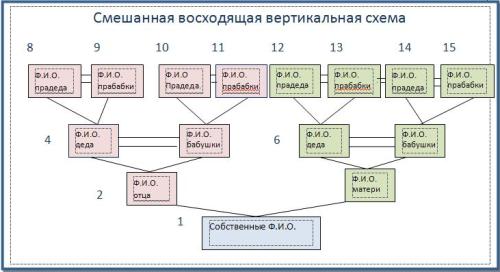Library dir - for beginners
For a beginner pedigree
Someday every person comes to the idea of restoring the ancestry of his family. Finding roots alone is difficult, if possible, then involve relatives and friends, as well as like-minded people. Our past is our roots, a person, like a tree does not live without roots.
Rules for compiling a pedigree tree.
1. The beginning of the countdown in the generational painting begins with the ancestor. For convenience in work, when drawing up a diagram, we use temporary numbering.
2. In the family tree diagram, the male line is filled on the left side.
3. At the first stage of the study of family history, there is an establishment of the identity, names, surnames of your direct ancestors.
4. The branches of the tree must be absolutely symmetrical, the number of branches at each new level must be even.
5. When filling out the working version of the tree diagram, each branch will be designated as fully as possible, i.e., so that it contains the first name, patronymic, last name, dates of life.
6. Don't put off until tomorrow what you can learn from family history today, especially if this information is kept by older people.
7. In the pedigree tree, enter only the exact names, accurate information.
Put the approximate data in the workbook in the "check" section. Anywhere else, inaccurate information must be accompanied by a question mark.
8. From the very beginning of the work on the pedigree in the workbook, enter all the interesting facts from the history of your family.



Sources of Genealogical Information.
1.Metric books, XVIII - early XX centuries.
2. Revision tales, from 1719 to 1858.
3.Issovednye vedomosti, late 18th - early 20th centuries.
4. All-Russian census of 1897.
5.All-Russian agricultural census of 1916, 1917.
6. Household inventories:
-deployment sentences, end of the 19th century.
- farm survey cards, early XX century.
7. Documents of collective farm accounting, 1929-1940s.
8.Address books, XVII century.
9.Scribe books, late 16th - 17th centuries
10.Census books, 17th century.
Secondary sources:
1.Address books of cities, late XIX - early XX century.
2. Encyclopedias and reference books.
3. Service lists.
4. Noble genealogical books.
5. Recruitment lists.
6. Shooting lists.
7.Books of Memory.
8 obituaries.
9. Documents of other organizations (museums, departments, information centers).
10.Moscow database, telephones, addresses (modern).
11. Correspondence of local authorities with individuals, early XX century.
12. Books of marriage search.
Non-standard sources:
1. Correspondence with the archives of the registry office.
2. Information on the Internet.
3. Regional databases, phone numbers, addresses (modern).
4.Documents from funds of state, public and private enterprises (railway, societies, factories, factories, etc.)
5.History of possessions.
6. Memorable books of the provinces.
Household books of the village councils.
Archives of party offices.
Sentinel census books.
Family books of villages.
Record books of the verdicts of the rural gathering.
Formulary lists of factories.







